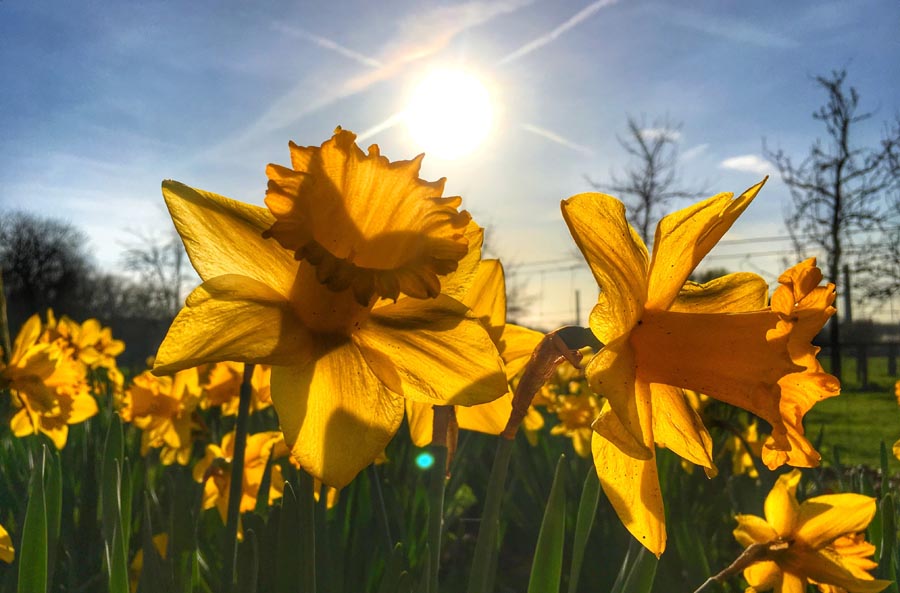
Are daffodils heliotropic? It is actually a really sensible question when you think about it.
There are some plants we know for sure are heliotropic, sunflowers probably being the most obvious example, but what about their cheery yellow friends, daffodils?
There is some science in the answer to this and I am happy to admit I learned quite a bit when I was doing my research.
So no more beating about the bush, let’s dive in and answer the question.
Are you with me?
Are Daffodils Heliotropic?
Daffodils are phototropic rather than heliotropic. These are two very similar principles with one slight difference. Phototropic plants are attracted to the source of the most light, this will nearly always be the sun, but could be a street light or a grow light for instance. Heliotropic plants are specifically attracted to the sun, rather than any light source.
What is Heliotropism?
Before we answer the main question, I think it is important to have a clear understanding of what heliotropism is.
In short, plants that track the sun are heliotropic.
‘Helio’ means sun and ‘tropism’ means turning/movement. Heliotropism was a principle first coined by that man of many talents Leonardo da Vinci.
When we say heliotropic plants track the sun, obviously the plant itself cannot physically move location, but its leaves or flowers will orientate themselves towards the sun throughout the day.
That is why, if you see a field of sunflowers first thing in the morning and then late in the afternoon, the heads of the sunflowers will have changed direction as they follow the sun across the sky.
When plants are young it is pretty clever how this happens.
The stem of a heliotropic plant will grow on the east side during the day, causing the head of the flower to bend from east to west – the direction the sun travels.
RELATED ===> Are Daffodils Vascular Or Nonvascular?
Then at night, as the sun sets, the west side of the stem grows, so the head of the plant bends back to the east and is ready to follow the sun again the next morning.
The light from the sun is important in providing the plant with the energy it needs for photosynthesis.
However, there is another similar phenomenon that you may confuse heliotropism with…
What is Phototropism?
That phenomenon is phototropism.
The principle of phototropism is broadly the same, however instead of being attracted to sunlight, phototropic plants are attracted to any kind of light.
So this could be a street light, a grow light or the sun.
An example of phototropism is when seedlings first emerge. In their desire for sunlight, they will often lean towards whatever light they can, and become leggy.
So the difference between heliotropic plants and phototropic plants is quite straightforward.
Heliotropic plants are attracted to the sun, whereas phototropic plants are attracted to any kind of light.
RELATED ===> Are Daffodils Gymnosperms?
Do Daffodils Face the Sun?
So you are here because you want to find out if daffodils are heliotropic, or in other words, if daffodils face the sun.
Daffodils prefer to align themselves with the sun, but will align themselves with the source of most light.
So essentially daffodils are phototropic, not heliotropic.
Gordon Hanks in his 2003 book Narcissus and Daffodil: The Genus Narcissus, reported this.
It was also backed up by Peter Greene in his 2020 study ‘Photo-sensitive “flip-flop” characteristics of the developing Narcissus plant’.
Greene said that of 193 daffodil stems he studied, 62% faced East, 17% faced South, 15% faced West, and only 6% faced North. He noted the way they faced did depend ‘strongly on the partial shading effect of the surrounding environment’.
He concluded:
“Said directionality (of the stems) is accomplished by stem bending, a phototropic response mechanism, which is sensitive to partial blocking of the available sunlight from the local environmental.”

This goes some way to answering another question I have heard asked regularly, that being why do daffodils all face the same way?
They all face the same way because they all want the same thing, to be facing in the sunniest direction.
It was Greene, in his study mentioned above, who also reported that daffodils “align and position their flower stems during development, with respect to sunrise, noontime, and sunset, so as to collect maximum solar radiation averaged throughout the day.”
In the interests of fairness, I will admit there does seem to be a bit of debate amongst gardeners as to whether daffodils track the sun throughout the day, but the scientific reports undoubtedly seem to provide solid evidence to support the idea that daffodils are phototropic.
RELATED ===> Why Are Daffodils Associated With Wales?
Final Thoughts
Daffodils are phototropic rather than heliotropic, although the principle is broadly the same.
Scientific studies have shown that daffodils will always orientate themselves in the direction with the most light.
Obviously, this light will nearly always be the sun, unless you have cut daffodils inside near some kind of artificial light, or one is growing on a road verge near a streetlight.
So we can say that if they are outside, and have nothing blocking their way daffodils will nearly always face the sun.
Next time you are in your garden take a look at your daffodils and the position of the sun, and I suspect there will be a correlation.
